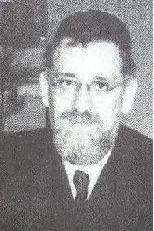Jacob Avigdor
Rabbi Dr. Yaakov Avigdor (also Jacob) (1896–1967) was a Polish rabbi, author and Holocaust survivor, who served as Chief Rabbi of Drohobych - Boryslav in Poland, and of the Ashkenazi Jewish community in Mexico.

Life
He was born into a rabbinic family in Tyrawa Wołoska, a shtetl in the Austrian province of Galicia between the cities of Sanok and Przemyśl (now southeast Poland) in 1896. He excelled in religious studies, and being considered a prodigy, was ordained at the young age of 16 years. Later he attended the universities of Kraków and Lviv, obtaining a PhD in Philosophy. Acquiring a high reputation as an orator and Talmudist, he was named Chief Rabbi of Drohobych and Boryslav, then in southeast Poland (now western Ukraine) in 1920 (age 24), where he officiated until the Nazi occupation. Being District Rabbi of about 80 surrounding villages, he also served as head ("Av") of the Beth din.
He officiated at the wedding of Menachem Begin which took place at his shul, the Choral Synagogue in 1939.
During the Holocaust, he lost his wife, his two daughters and his brother David the Rabbi of Andrychów, among many family members. After his liberation from the Buchenwald concentration camp, Avigdor became extremely active in the efforts of rescue and rehabilitation of Jewish refugees in postwar Europe. Upon immigrating to the U.S. in 1946, he accepted a pulpit in Brooklyn, New York, and six years later he was offered the rabbinate of Mexico, holding that position until his death in Mexico City in 1967.
Avigdor was much consulted on religious and ethical questions by worldwide peers. A prolific writer, his topics included religious philosophy, Jewish history and traditions, and commentary on Biblical text. Most of his prewar works were lost. In Mexico, he became a regular contributor to Yiddish periodicals, and published books in that language, Hebrew and Spanish. The Holocaust Museum at Yad Vashem holds a Hebrew calendar written by him from memory during his stay at Buchenwald (see below External Links).
Reuniting with son Isaac
Rabbi Avigdor's son, Rabbi Isaac C. Avigdor, also survived the war (at Mauthausen concentration camp). He had seen the death of a man, and not long after the war, at a DP camp in Italy, he wrote a document for his widow as witness. As she relocated (to Germany) and wanted to remarry, the senior Rabbi Jacob Avigdor, head of the local Jewish court, needed proof that the woman's husband had died. She gave Rabbi Jacob the formal document written by Rabbi Isaac. This is how the father found out the son was still alive, allowing them to reunite, many months after the war.
Rabbi Isaac included this story in a book about his father's life, Faith After the Flames: The Life of Rabbi Dr. Yaakov Avigdor and details are included in a published book review.[1] The story of the father, the son, and the widow is also told by Holocaust writer Esther Farbstein in her Hidden in Thunder: Perspective on Faith, Halachah and Leadership, volume 1 [2]
Works
- Nauka Talmudu -1928 (Polish, with subsequent Hebrew and German editions, three volumes)
- Chelek Yacov - 1929 (Hebrew)
- Metafizyka Judaismu -1931 (Polish, Doctorate Thesis, Lviv University)
- Haemunah V'haphilosophia‡ -1933 (Polish)
- Sheelot Utshuvot Abir Yacov -1934 (Hebrew, two volumes)
- Harambam V'shitato B'philosophia‡ -1935 (Polish)
- Ayeh Sofer -1937 (Hebrew)
- Torat Halashon -1938 (Hebrew)
- Sheelot Utshuvot Heshiv Yacov -1939 (Hebrew)
- Al Hashchitah‡ - 1939 (Polish)
- Techiyat Yacov -1950 (Hebrew)
- La Cronología Judaica -1954 (Spanish)
- Maimónides, su Vida y Obra -1955 (Spanish)
- [Chelek Yacov Aleph - 1956 reprint of Chelek Yacov]
- [Chelek Yacov Bet - 1956 reprint of Ayeh Sofer and Techiyat Yacov].
- Kuntres Kol Yacov -1956 (Hebrew)
- Shevichtav V'sheval Peh (In Shrift Un Vort) - 1957 (Yiddish, volumes I and II) and 1958 (Yiddish, volume III)
- La Vision del Judaismo -1959 (Spanish, two volumes)
- Machshoveh V'loshn (Gedank Un Shprach) -1959 (Yiddish)
- Reflexiones Sobre la Torá -1960 (Spanish)
- Dee Yiddishe Froy/La Mujer Judía - 1960 (Yiddish and Spanish)
- Hegyon Yacov -1962 (Yiddish, two volumes)
- Torah Sh’veal Peh -1962 (Yiddish, volume I) and 1963 (Yiddish, volume II)
- Haskel V'yadoa -1962 (Hebrew, volumes I and II) and 1963 (Hebrew, volume III)
- Der Yiddisher Shabos/El Sabado Judío -1963 (Yiddish and Spanish)
- Haemuna Hanotzrit L'or Hahalacha Hayehudit -1964 (Hebrew)
- Oifzatzn Un Esayen -1965 (Yiddish)
- Mikdash Meat -1965 (Hebrew)
- Mul Baayot Hador -1965 (Hebrew, volume I) and 1966 (Hebrew, volume II)
- Síntesis del Talmud: Exposición de su Desarrollo Histórico -1966 (Spanish, two volumes)
(‡ Hebrew translation of the Polish title per biographical source in the Hebrew language; original Polish title unknown)
References
- Martyrdom and Resistance, ISSN 0893-1571, Vol.32-No.2, Nov/Dec 2005, page 4 (2005). "Book Review by David Warren".CS1 maint: multiple names: authors list (link)
- Esther Farbstein. Hidden in Thunder: Perspective on Faith, Halachah and Leadership, volume 1. ISBN 965-726505-3.
3. Avigdor, Jacob. Sheelot Utshuvot Abir Yacov. (Autobiographical essay as preface). Reprint of 1934 edition. New York, 1949. {trans: Questions and Answers "Abir Yacov"}.
4. Farbstein, Esther. The Forgotten Memoirs. Shaar Press, New York, 2011.
5. Gelber, N.M. Sefer Zikaron L'Drohobych, Boryslaw V'ha-seviva. Tel-Aviv, 1959. {trans: Book of Remembrance to the Jews of Drohobych, Boryslaw, and Surroundings}.
6. Wunder, Meir. Meore Galitsyah: Entsiklopedyah L'chachme Galitsyah, Machon L'hantsachat Yehadut Galitsyah, Jerusalem, 1978. {trans: Encyclopedia of Galician Rabbis and Scholars}.
External links
- Hebrew Calendar written by Rabbi Avigdor in Buchenwald, Yad Vashem website.
- The Religious Life of the Jews of Drohobycz (Avigdor is mentioned in the fifth paragraph).
- History of the Jews of Boryslaw (Avigdor is mentioned in last two paragraphs).
- The Jewish Party in the Drohobych City Council of 1932 (Avigdor's picture is shown on Plate VIII, third photograph).
- "Faith After the Flames: The Story of Rabbi Dr. Yaakov Avigdor," (Book Review).